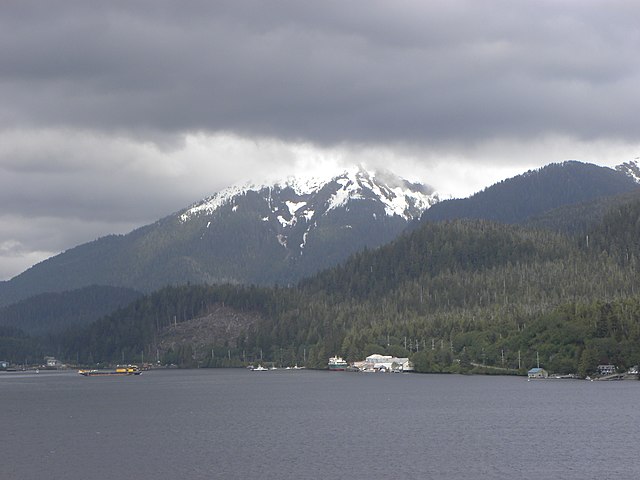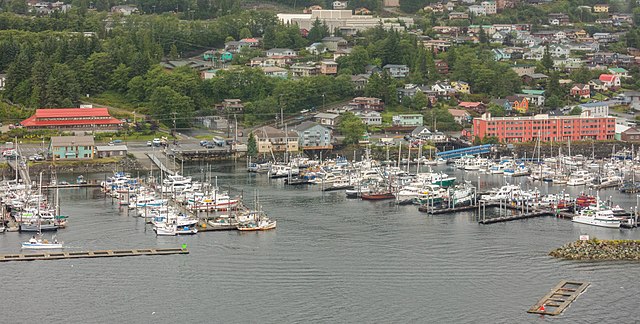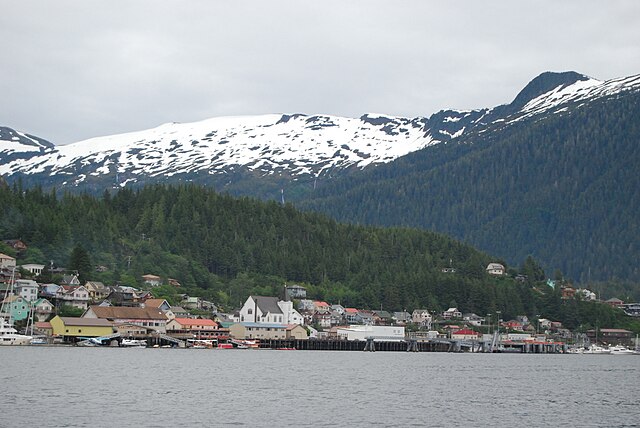Picture this: you’re standing on a misty dock in Ketchikan, Alaska, with the scent of saltwater and cedar in the air, and a soft drizzle kissing your face. Welcome to the weather of Ketchikan—a place where rain is as much a resident as the locals. But don’t let the word “rain” scare you off! Ketchikan’s climate is a fascinating mix of wet, wild, and wonderful, shaping everything from its lush rainforests to its vibrant lifestyle. Whether you’re planning a cruise stop, a fishing trip, or a move to this coastal gem, understanding Ketchikan’s weather is key to making the most of your experience. So, grab a cup of coffee, and let’s dive into what makes Ketchikan’s weather so unique.
Why Ketchikan’s Weather Stands Out
Ketchikan, often called the “Salmon Capital of the World,” sits on Alaska’s southeastern panhandle, nestled in the heart of the Tongass National Forest—the largest temperate rainforest in the world. This location gives Ketchikan a climate unlike anywhere else. It’s not just about rain (though there’s plenty of that); it’s about a dynamic weather system influenced by the Pacific Ocean, rugged mountains, and a northern latitude. The result? A place where you can experience all four seasons in a single day, with temperatures that rarely swing to extremes but always keep you guessing.
The Role of Geography in Ketchikan’s Climate
Ketchikan’s weather is like a symphony conducted by its geography. The town hugs Revillagigedo Island, surrounded by ocean channels and backed by steep, forested mountains. The Pacific Ocean acts like a giant thermostat, keeping winters mild and summers cool. Meanwhile, the mountains trap moisture-laden clouds rolling in from the sea, making Ketchikan one of the wettest places in the U.S. On average, the town sees about 150 inches of rain annually—imagine filling a kiddie pool 12 feet deep every year! This constant moisture feeds the lush greenery that makes Ketchikan feel like a living postcard.
How the Ocean Keeps Things Steady
The Pacific Ocean is Ketchikan’s climate MVP. Its warm currents, like the Alaska Current, prevent the town from plunging into Arctic-level cold, even in the dead of winter. January, the coldest month, averages around 33°F—chilly but not frostbite territory. In summer, July highs hover around 65°F, perfect for hiking or fishing without breaking a sweat. This oceanic influence means you won’t need a parka or a sunhat most days, but you’ll definitely want a good rain jacket.
A Year in Ketchikan: Seasonal Weather Patterns

Ketchikan’s weather doesn’t follow a boring script. Each season brings its own personality, from drizzly winters to foggy summers. Let’s break it down so you know what to expect, whether you’re visiting for a week or settling in for the long haul.
Spring: A Time of Transition
Spring in Ketchikan, from March to May, is like waking up from a long nap. Days get longer, temperatures climb into the 40s and 50s, and the rainforest bursts into green. But don’t ditch your umbrella just yet—rain is still a frequent guest, with April often seeing 15-20 rainy days. The upside? Spring showers bring wildflowers, and the crisp air is perfect for exploring trails like Deer Mountain. Pack layers and waterproof boots, and you’ll be ready for whatever Mother Nature throws your way.
Wildlife and Weather in Spring
Spring weather also wakes up Ketchikan’s wildlife. As temperatures warm, bears emerge from hibernation, and salmon start their upstream journey. The mild, wet conditions create a buffet for bald eagles, who swoop down to snatch fish from misty streams. If you’re a nature lover, spring’s weather sets the stage for unforgettable wildlife sightings—just keep your camera dry!
Summer: Ketchikan’s Golden Season
Summer, from June to August, is Ketchikan’s time to shine—literally. With up to 18 hours of daylight, the town buzzes with cruise ships, fishermen, and adventurers. Temperatures range from 50°F to 65°F, and while rain is less frequent (about 10-15 rainy days per month), fog often rolls in, cloaking the harbor in a mystical haze. Summer’s mild weather is ideal for kayaking, zip-lining, or strolling through Totem Bight State Park. Pro tip: bring sunscreen for those rare sunny days when the sky opens up like a blue canvas.
Fog: The Silent Summer Guest
Fog is summer’s sneaky sidekick in Ketchikan. Cool ocean air meets warmer land, creating thick, soupy fog that can linger for hours. It’s not uncommon for cruise passengers to wake up to a “whiteout” view from their ship. But don’t worry—the fog often burns off by midday, revealing jaw-dropping views of mountains and sea. Think of it as nature’s way of adding a little drama to your morning coffee.
Fall: A Colorful, Rainy Affair
Fall, from September to November, paints Ketchikan in shades of gold, red, and orange. Temperatures drop to the 40s and 50s, and rain ramps up, with October being the wettest month (up to 25 inches!). Storms from the Pacific can bring gusty winds, making the harbor a lively place to watch fishing boats bob. Fall’s weather is perfect for cozying up in a waterfront café or visiting the Southeast Alaska Discovery Center to learn about the rainforest’s resilience.
Storm-Watching in Fall
If you’re a fan of nature’s raw power, fall in Ketchikan is your season. Pacific storms roll in like uninvited guests, bringing wind speeds of 20-30 mph and waves that crash against the shore. Locals embrace these stormy days, sipping hot cocoa and watching the drama unfold from cozy homes. For visitors, it’s a chance to see Ketchikan’s wild side—just don’t forget your rain gear!
Winter: Mild but Wet
Winter in Ketchikan, from December to February, isn’t the snowy wonderland you might expect from Alaska. Thanks to the ocean’s influence, snow is rare at sea level, with rain dominating the forecast (15-20 inches per month). Temperatures hover in the 30s, but wind chill can make it feel colder. Winter’s short days—about 6 hours of daylight—create a cozy vibe, perfect for exploring indoor attractions like the Totem Heritage Center or warming up in a local brewery.
Rare Snow Days in Ketchikan
When snow does fall in Ketchikan, it’s a big deal. Kids race outside to build snowmen, and the town takes on a magical, hushed quality. But don’t expect it to last—rain usually washes it away within days. If you’re chasing snow, head to higher elevations like Ward Lake, where you might catch a dusting perfect for a quick snowball fight.
How Ketchikan’s Weather Shapes Its Culture

Ketchikan’s weather isn’t just a backdrop—it’s a way of life. From the Tlingit people who’ve thrived here for centuries to modern-day fishermen, the climate has shaped traditions, livelihoods, and even the town’s quirky sense of humor. Locals don’t complain about the rain; they embrace it, calling themselves “rainforest people” with pride. Festivals like the Blueberry Arts Festival in August thrive despite drizzle, and you’ll see kids splashing in puddles while parents sip coffee under awnings.
Fishing and the Weather Connection
Ketchikan’s fishing industry—think salmon, halibut, and crab—depends on the weather. Rain keeps rivers flowing, creating ideal conditions for salmon runs. Fishermen brave foggy mornings and stormy seas, guided by a deep respect for nature’s rhythms. If you’re an angler visiting Ketchikan, check the forecast but don’t let a little rain stop you—some of the best catches happen on drizzly days!
Rain Gear: Ketchikan’s Fashion Statement
In Ketchikan, rain gear isn’t just practical—it’s a fashion statement. Forget flimsy ponchos; locals rock high-quality rain jackets, waterproof hats, and Xtratuf boots (aka “Ketchikan sneakers”). Visitors quickly learn that a good raincoat is worth its weight in gold. Pro tip: skip the umbrella—it’s no match for Ketchikan’s sideways rain and gusty winds.
What to Pack for Ketchikan’s Weather
Packing for Ketchikan is like preparing for a choose-your-own-adventure book. The weather can shift from sunny to stormy in hours, so versatility is key. Start with a waterproof jacket and pants—look for breathable materials like Gore-Tex. Layer up with moisture-wicking base layers, fleece for warmth, and quick-dry clothing. Waterproof boots are a must for muddy trails, and don’t forget a hat to keep rain off your face. For summer, toss in a light scarf or buff for foggy mornings, and in winter, add gloves and a warm beanie.
Accessories for All Seasons
Beyond clothing, a few accessories can make or break your Ketchikan trip. A dry bag is essential for keeping your phone and camera safe during kayaking or boat tours. Binoculars are great for spotting eagles or whales through the mist. And don’t skip the lip balm and moisturizer—constant moisture can chap your skin faster than you’d think. Think of your packing list as your armor against Ketchikan’s weather dragon—you’ll be ready to slay it!
Tips for Enjoying Ketchikan in Any Weather

Ketchikan’s weather might sound daunting, but with the right mindset, it’s part of the adventure. Embrace the rain like a local—grab a coffee at The Point Café and watch the harbor come alive. On foggy days, explore indoor gems like the Great Alaskan Lumberjack Show. For sunny moments, hit the trails or book a floatplane tour for jaw-dropping views. The key? Stay flexible and let the weather guide your plans, not ruin them.
Weather Apps and Resources
To stay ahead of Ketchikan’s mercurial weather, arm yourself with the right tools. Apps like AccuWeather or Weather Underground offer detailed forecasts, including wind speed and precipitation chances. Check local sources like ketchikandailynews.com for real-time updates. Pro tip: ask locals for their weather wisdom—they’re better than any app at predicting when the fog will lift or the rain will pause.
[](https://www.ketchikandailynews.com/weather/)
Conclusion: Embrace Ketchikan’s Weather Adventure
Ketchikan’s weather is more than a forecast—it’s a character in the town’s story. From misty mornings to stormy afternoons, the climate shapes everything from the rainforest’s emerald glow to the resilience of its people. Whether you’re chasing salmon, exploring totem poles, or simply soaking in the views, Ketchikan’s weather adds a layer of magic to every moment. So, pack your raincoat, leave your umbrella at home, and dive into the wild, wet wonder of Ketchikan. What’s a little rain when you’re in the heart of Alaska’s rainforest?
FAQs About Ketchikan Weather
1. How much rain does Ketchikan really get?
Ketchikan averages about 150 inches of rain a year, with October being the wettest month. That’s enough to make you feel like you’re living in a cloud, but locals take it in stride!
2. Is it always raining in Ketchikan?
Not always, but rain is a frequent visitor—expect 200-250 rainy days annually. That said, summer brings drier spells, and even rainy days often have breaks for outdoor fun.
3. What’s the best time to visit Ketchikan for good weather?
Summer (June to August) offers the mildest temperatures and less rain, plus long daylight hours. It’s perfect for cruises, fishing, or hiking, though fog can add some mystery.
4. Does Ketchikan get a lot of snow?
Snow is rare at sea level, with rain dominating winter. Higher elevations might see some flurries, but don’t expect a winter wonderland unless you head inland.
5. What should I wear in Ketchikan?
Think layers: a waterproof jacket, quick-dry pants, fleece, and sturdy boots. Xtratuf boots are a local favorite, and a hat beats an umbrella any day in Ketchikan’s wind.

